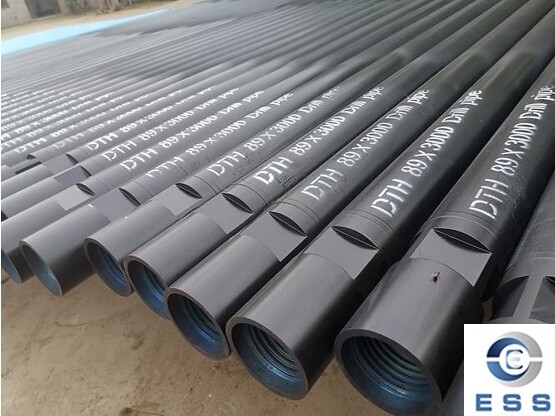
Drill pipe is a very important tool in drilling operations, mainly used to transmit
rotational power and withstand the pressure generated during drilling. They can
be divided into multiple types and different specifications according to
different application scenarios, technical requirements and structural
characteristics.
Single-layer joint drill pipe
Single-layer joint drill pipe is a common
type of drill pipe, and seamless
steel pipe is often used as the material. It is characterized by a single
drill pipe and a joint. The joint is used to connect two drill pipes to ensure
that the overall length is suitable for different drilling depths. It is
generally suitable for simpler drilling tasks, and is easy to maintain and low
in cost.
Its specifications are shown in the
following table:
|
Drill pipe model
|
Outer diameter (inch)
|
Length (feet)
|
|
NWJ
|
2 3/8
|
10
|
|
HWJ
|
3 1/2
|
10
|
|
PWJ
|
4 1/2
|
15
|
Double-layer joint drill pipe
Double-layer joint drill pipe is more
widely used. It is composed of two drill pipes and multiple joints. Compared
with single-joint drill pipe, double-layer joint drill pipe is more outstanding
in strength and durability. It is suitable for deep drilling and withstands higher
pressure and load.
Its specifications are shown in the
following table:
|
Drill pipe model
|
Outer diameter (inch)
|
Length (feet)
|
|
NZ
|
2 3/8
|
6-10
|
|
HZ
|
3 1/2
|
6-10
|
|
PZ
|
4 1/2
|
10-15
|
Box drill pipe
Box drill pipe is a special type of drill
pipe. Its design allows the drill pipe to remain stable under high load. Box
drill pipe is usually used for deep well drilling or special drilling
environment, and has stronger pressure resistance and wear resistance.
Its specifications are shown in the
following table:
|
Drill pipe model
|
Box length (inch)
|
Segment length (foot)
|
|
HH
|
18
|
10
|
|
PH
|
18
|
15
|
|
CH
|
18
|
20
|
Internal impact drill pipe
Internal impact drill pipe is a type of
internally driven drill pipe. The structural design allows the impact force to
be effectively transmitted between the drill bit and the drill pipe. When
drilling hard rock or encountering obstacles, this drill pipe effectively
breaks the rock formation through the reaction force generated by the internal
impact head.
Its specifications are shown in the
following table:
|
Drill pipe model
|
Outer diameter (inch)
|
Impact head length (inch)
|
|
DHD 340A
|
4 1/2
|
12
|
|
DHD 350R
|
5 1/2
|
14
|
|
DHD 360
|
6 1/2
|
16
|
External impact drill pipe
External impact drill pipe is also a
commonly used type of drill pipe. Similar to internal impact drill pipe, it is
also used for difficult drilling operations, but its impact force transmission
is completed through an external device. This type of drill pipe is usually
used for drilling tasks in hard rocks or obstacles that need to be broken.
Its specifications are shown in the
following table:
|
Drill pipe model
|
Outer diameter (inch)
|
Impact head length (inch)
|
|
SD 4
|
2 5/8
|
10
|
|
SD 5
|
3 1/8
|
12
|
|
SD 6
|
3 1/2
|
14
|
Double round drill pipe
Double round drill pipe is a type of drill
pipe used for mud circulation. It usually needs to be assisted by special pup joints and casing pipes.
Its uniqueness lies in the different inner and outer diameters of the drill
pipe, which can effectively optimize the circulation process of mud, help
reduce friction during drilling and increase drilling speed.
Its specifications are shown in the
following table:
|
Drill pipe model
|
Inner diameter (inch)
|
Outer diameter (inch)
|
|
NC 23
|
2 1/4
|
3
|
|
NC 26
|
2 3/8
|
3 1/2
|
|
NC 31
|
2 7/8
|
4
|
Summary
Drill pipes of different types and
specifications have their own unique application scenarios in different
projects. The above is an introduction to the specifications and models of
various drill pipes. If you need more detailed information, please refer to the
relevant product written materials or consult relevant professionals. By
properly selecting the drill pipe model, drilling efficiency can be improved
and operational risks can be reduced.
Read more: Size of Drill Pipe or How Many Types of Drill Pipe Threads Are There?













 Eastern Steel Manufacturing Co.,Ltd not only improve product production and sales services, but also provide additional value-added services. As long as you need, we can complete your specific needs together.
Eastern Steel Manufacturing Co.,Ltd not only improve product production and sales services, but also provide additional value-added services. As long as you need, we can complete your specific needs together.










